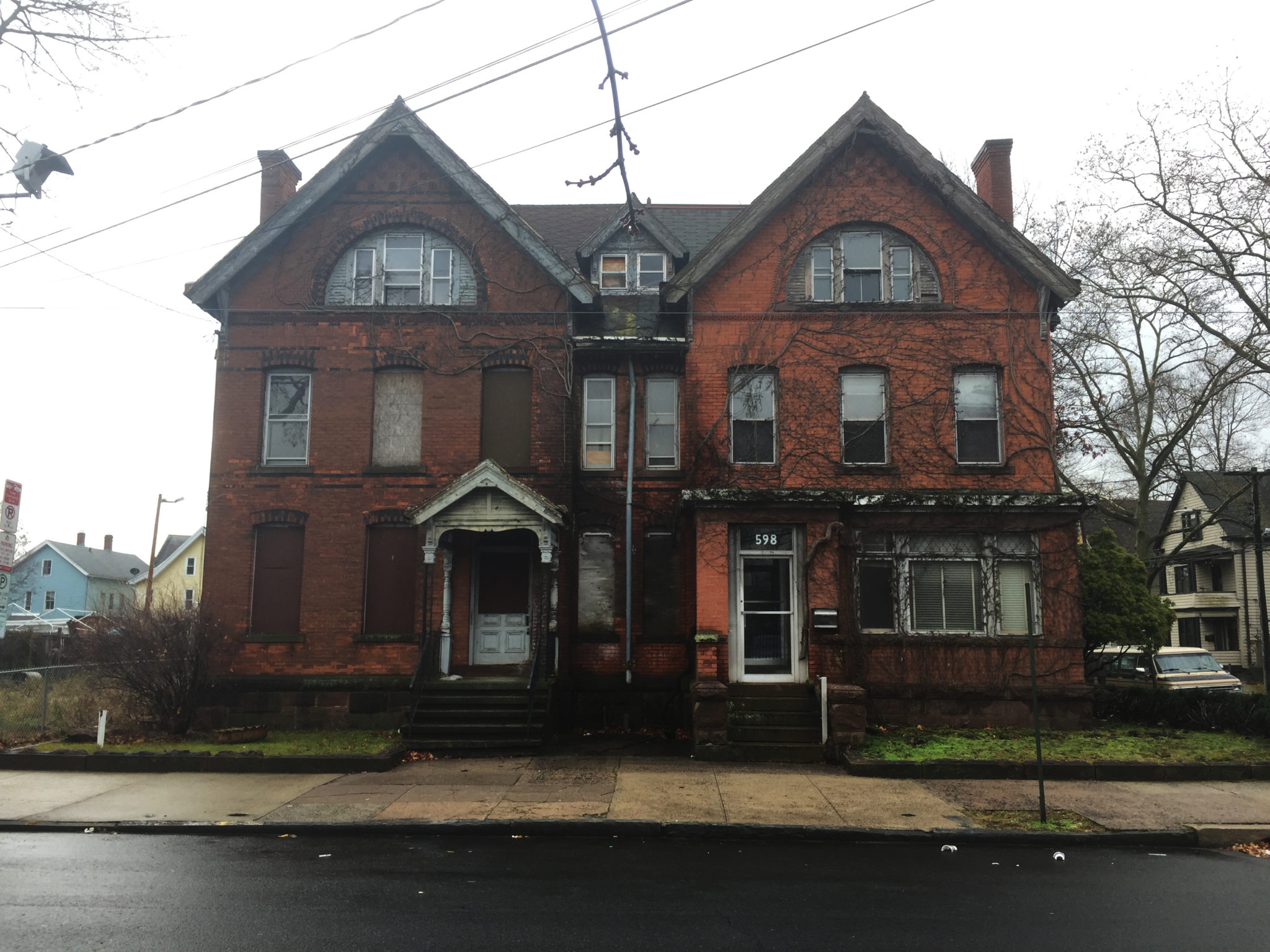
As winter snow begins to fall on the 596–598 George St. complex, Dwight Street residents await the future of one of their neighborhood’s architectural gems.
A plan to demolish the 130-year-old building, which is owned by Yale New Haven Hospital and has been abandoned for nearly two decades, is currently on hold after frustrated residents submitted proposals for its reuse.
“There’s nothing that would warrant demolition. There’s a leaky roof in one section: what we routinely deal with. Nothing scary,” said Henry Dynia, director of design and construction for Neighborhood Housing Services of New Haven. “Someone may use something like that as an excuse to destruct the building if they wanted to use the space for something else.”
Yale New Haven Hospital filed an application to demolish its 596–598 George St. complex in April 2015 to replace the current building with single-family housing. After finding evidence that the structure, which is registered with the National Register of Historic Places, had alternative reuses, the city recommended in July 2015 that the hospital not demolish the building.
Mark D’Antonio, a spokesman for Yale New Haven Hospital, said there is no plan in place to move forward with the project.
After the plan was halted, the hospital offered a compromise to the city in which the new living spaces could only be occupied by those who purchased them. The hospital believed the homeownership model would sustain the neighborhood’s vitality.
Before the hospital decided on the restriction, the roughly 5,000-square-foot building received interest from real estate agencies and other organizations.
National realtor Marcus & Millichap offered its marketing services to sell the property, wrote Westley Klockner, an investment associate with the firm, in a letter obtained by the News.
Neighborhood Housing Services of New Haven offered to buy the property and convert it into rental homes that would likely be occupied by hospital workers, Dynia said. His organization sent Yale New Haven Hospital a detailed proposal and anticipated hardly any issues with the structure’s stability after surveying the site, Dynia said.
The complex could probably accommodate eight apartment units, said Olivia Martson, a local real estate agent, former alder for Ward 2 and the founder of Friends of Dwight Street Historic District.
The building was built as a house in the 1880s for Clarence Blakeslee, class of 1885, and his brother, Theodore Blakeslee — presumably by their father’s contracting company, said Christopher Wigren, deputy director of the Connecticut Trust for Historic Preservation. Decades later, spouses Bernard Conte and Marianne Beatrice used the complex’s space for over 40 years to deliver babies, Martson said.
The Hospital of Saint Raphael bought the structure in September 2002, but never saw it occupied. After acquiring Saint Raphael’s, Yale New Haven Hospital came into ownership of the property in September 2012.
When the complex was under the ownership of Saint Raphael’s, the Dwight Street Historic District saw hope in retaining the historical property, given that in previous years it saw another architecturally significant structure renovated with community involvement.
About a decade ago, Saint Raphael announced that it would demolish 1389 Chapel St., Dynia said. The hospital approximated at $300,000 the costs to environmentally remediate the building before destruction. In response, Neighborhood Housing Services of New Haven offered to both remediate the building and repair its exterior for the same price, Dynia said.
The group avoided the property’s destruction. And, eventually, the interior was renovated and the space is now leased to the Sickle Cell Disease Association of America Southern Connecticut, Martson said.
“I think we’re working in the right direction with that,” Martson said.
Though the 1389 Chapel St. reclamation brought optimism, Dwight Street residents remain concerned about Yale New Haven Hospital purchasing properties throughout their neighborhood. After purchasing buildings, the hospital frequently leaves them to rot, Dwight Street resident and FDSHD member Victoria Vebell said.
And with heavy snowfalls expected soon, residents hope the 596–598 George St. complex is not further damaged.
“Without some attention, another winter and the damage the weather causes can push [the complex] over the edge,” Vebell said.
If enough damage is caused, Vebell added, no one will want to repair it.
This situation would not be an anomaly: Local business J. Press was forced to shut its doors on 262 York St. and was eventually demolished because of winter storm Nemo’s snow in February 2012, Wigren said.
Though Martson is not especially worried about another winter, she does not want Yale New Haven Hospital to neglect the building so it can “tear it down” in five years time, Martson said.
The Connecticut Environmental Protection Act mandated Yale New Haven Hospital to file a 90-day delay of demolition and may also protect buildings like 596–598 George St. that face demolition by neglect, Wigren said.
The law, which allows any citizen to file a lawsuit to prevent the unreasonable destruction of a historically significant building, has never been used this way in the state, he added, since someone has to use their time and money to bring the lawsuit.
No persons interviewed mentioned exploring a lawsuit for this specific case. Instead, they expressed hope that the hospital begins protecting the complex soon.
“Certainly, it’s not benefiting from being neglected,” Herzan said.
Yale New Haven Hospital was founded in 1826, predating 596–598 George St. by roughly six decades.
Interested in getting more news about New Haven? Join our newsletter!







